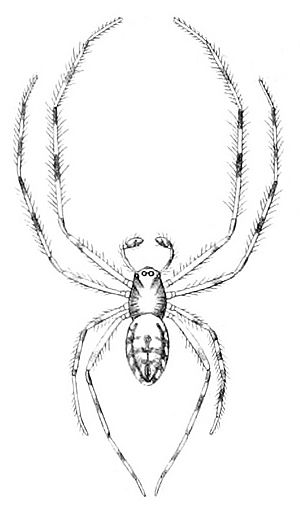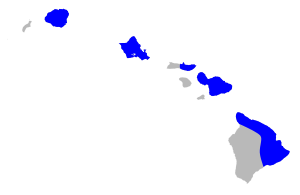Orsonwelles facts for kids
Quick facts for kids Orsonwelles |
|
|---|---|
 |
|
| Orsonwelles graphicus | |
| Scientific classification |
|
| Kingdom: | Animalia |
| Phylum: | Arthropoda |
| Subphylum: | Chelicerata |
| Class: | Arachnida |
| Order: | Araneae |
| Infraorder: | Araneomorphae |
| Family: | Linyphiidae |
| Genus: | Orsonwelles Hormiga, 2002 |
| Type species | |
| O. polites Hormiga, 2002
|
|
| Species | |
|
13, see text |
|
 |
|
| Range of Orsonwelles in the Hawaiian Islands | |
Orsonwelles is a group of spiders, called a genus, found only in the Hawaiian Islands. These spiders are a type of dwarf spider, but they are actually quite large for their family! Each kind of Orsonwelles spider lives on just one island, usually high up in the mountains.
Scientists first described these spiders in 2002. The genus was named after the famous actor and filmmaker Orson Welles. Many of the spider species are even named after his movies or characters! Sadly, one species has not been seen since the 1890s and might be extinct.
Contents
About Orsonwelles Spiders
The first Orsonwelles spiders were described way back in 1900 by a French scientist named Eugène Simon. He gave them different names back then. Later, in 2002, Gustavo Hormiga discovered eleven new species and created the new genus Orsonwelles. He then moved the spiders Simon found into this new group too.
What They Look Like
Orsonwelles spiders have dark brown or gray bodies. Their main body part, called the carapace, often has a light stripe down the middle. Their abdomen (the back part of their body) is oval-shaped. Sometimes, it has light spots or zigzag patterns.
A special feature of these spiders is on their legs. They have tiny hairs called trichobothria on their third and fourth leg pairs. This is unique among dwarf spiders. They also have very large chelicerae (mouthparts) with many teeth.
Where They Live
These spiders mostly live in the leftover parts of rainforests and mixed forests. Many prefer higher places where there are fewer human disturbances and fewer non-native plants or animals. However, some can be found in disturbed areas as low as 500 meters (about 1,640 feet) above sea level.
Their Size
Orsonwelles spiders are known for being the largest members of their spider family, Linyphiidae. This is partly because of something called island gigantism. This is when animals on islands grow bigger than their relatives on mainlands.
Female Orsonwelles spiders can grow from 8.06 to 14.07 millimeters long. Males are a bit smaller, reaching 6.2 to 11.35 millimeters. The biggest ones belong to the species O. malus. To give you an idea, the next largest spider in their family is less than 10 millimeters long!
What They Eat
Orsonwelles spiders are active at night. During the day, they hide. At night, they hang upside down in the middle of their webs, waiting for prey. Their big mouthparts with teeth help them eat many different kinds of small creatures. They are generalist predators, meaning they don't just eat one type of food. They catch and eat various arthropods, including moths and small land amphipods.
Sometimes, smaller spiders from the genus Argyrodes try to steal food from Orsonwelles webs. These are called kleptoparasites. But sometimes, these smaller spiders get caught in the Orsonwelles webs themselves!
Orsonwelles Species
Each species of Orsonwelles spider lives on only one island in Hawaii. As of May 2019, there are thirteen known species:
- Orsonwelles ambersonorum (Hormiga, 2002) – Found on Oahu. Named after Welles' 1942 film The Magnificent Ambersons.
- Orsonwelles arcanus (Hormiga, 2002) – Found on Oahu. Named after Welles' 1955 film Mr. Arkadin. Arcanus means "hidden" in Latin.
- Orsonwelles bellum (Hormiga, 2002) – Found on Kauai. Named after Welles' 1938 radio show The War of the Worlds. Bellum means "war" in Latin.
- Orsonwelles calx (Hormiga, 2002) – Found on Kauai. Named after Harry Lime, a character Welles played in the 1949 film The Third Man. Calx means "lime" in Latin.
- Orsonwelles falstaffius (Hormiga, 2002) – Found on Maui. Named after the character Falstaff, whom Welles played in his 1966 film Chimes at Midnight.
- Orsonwelles graphicus (Simon, 1900) – Found on Hawaii. Graphicus means "belonging to painting or drawing" in Latin.
- Orsonwelles iudicium (Hormiga, 2002) – Found on Kauai. Named after Welles' 1962 film The Trial. Iudicium means "judgement" or "trial" in Latin.
- Orsonwelles macbeth (Hormiga, 2002) – Found on Molokai. Named after Welles' 1948 film Macbeth.
- Orsonwelles malus (Hormiga, 2002) – Found on Kauai. Named after Welles' 1958 film Touch of Evil. Malus means "evil" in Latin.
- Orsonwelles othello (Hormiga, 2002) – Found on Molokai. Named after Welles' 1952 film Othello.
- Orsonwelles polites (Hormiga, 2002) (type) – Found on Oahu. Named after Welles' 1941 film Citizen Kane. Polites means "citizen" in Greek.
- Orsonwelles torosus (Simon, 1900) – Found on Kauai. Torosus means "muscular" or "fleshy" in Latin. This species has not been seen since the 1890s and is thought to be extinct.
- Orsonwelles ventus (Hormiga, 2002) – Found on Kauai. Named after Welles' unfinished film The Other Side of the Wind. Ventus means "wind" in Latin.
See also
 In Spanish: Orsonwelles para niños
In Spanish: Orsonwelles para niños

